 Why did the Advertising Standards Bureau not ban this ad? The RTA Pinkie campaign humiliates the very ego-driven group of people who are yearning for acceptance. It demeans males by saying that a small penis is a bad thing. Now guys have to find even more ways to prove their manhood.
Why did the Advertising Standards Bureau not ban this ad? The RTA Pinkie campaign humiliates the very ego-driven group of people who are yearning for acceptance. It demeans males by saying that a small penis is a bad thing. Now guys have to find even more ways to prove their manhood.
This article is Part 2. It was split because the file size was becoming too large.
Please start by reading Part 1 by clicking here.
3) Is the campaign focussing on the penis?
One person who complained to the Advertising Standards Bureau said, ‘Genitals of young men have nothing to do with bad driving. The add (sic) is designed to be sexist and humiliating to men. The add (sic) encourages and sanctions from a government body the sexual harassment of young men with these crude, sexist and offensive behaviours.’ In response, the Roads and Traffic Authority, being the advertiser, responded to the Bureau, saying, ‘The response to the campaign by the focus groups was overwhelmingly positive. Most people involved in the groups knew about the Pinkie gesture. The groups recommended that the RTA proceed with the campaign because: It had the potential to change the behaviour of the target audience; It is powerful, it is different and it effectively utilizes social disapproval of poor driving behaviour by peers and the wider community; It puts the issue back in to the hands of the community; and the campaign is preventative.’
Let us examine these points. 1) Of course people would have known about the Pinkie gesture? So what? A universal insult is not lessened due to its popularity. The converse is true. In the 1994 film, ‘The Adventures of Priscilla, Queen of the Desert’, there is a scene in which an angry wife insults her husband by giving him the pinkie while saying something like, ‘And you have a small dingaling.’ The derogatory tone of that insult goes back a long time. 2) The RTA said that the focus group felt that the pinkie insult has potential to change behaviour. Most forms of bullying do change behaviour. Beating people over the head changes behaviour. The efficacy of derision does not justify it execution. As per the analogy featured in Part 1 of this article, hitting girls could change their behaviour and attitude towards smoking. That is no defence and no excuse. 3) The RTA says that the pinkie gesture is powerful, different and shows disapproval. Of course a grand insult is powerful. And yes, it is different because such bold and brazen advertisements are not common. How can the Bureau accept this type of response from the RTA? If beating young girls helps some of them to stop smoking, would it stack up if an advertiser said that hitting children is understood to be a sign of disapproval and not a sign of abuse? Would a campaign of tough-love that involves spanking be approved if it can be shown to be effective and powerful-enough to change behaviour? The submission by the RTA is disrespectful and does not answer the questions. The acceptance of the RTA’s response by the Bureau and the Board shows a lack of depth in the investigation process.
The Bureau and the Board and the RTA have failed to address the question. Therefore, they ought to re-open the cases and start again.
![]() Every time that someone objects to the ads, the question of humiliation is dismissed, and the focus on the penis is ignored, and the reference to the size of a penis is overlooked. However, we learn a lot from a submission by the RTA and the advertising agency (Clemenger BBDO) to the Effie Awards. Incidentally, we are told that the Effie Awards were introduced in 1968 by the New York Marketing Association. These are now held in 39 countries.
Every time that someone objects to the ads, the question of humiliation is dismissed, and the focus on the penis is ignored, and the reference to the size of a penis is overlooked. However, we learn a lot from a submission by the RTA and the advertising agency (Clemenger BBDO) to the Effie Awards. Incidentally, we are told that the Effie Awards were introduced in 1968 by the New York Marketing Association. These are now held in 39 countries.
In the submission to the Awards, both the RTA and Clemenger BBDO state that the $2 million pinkie campaign ‘provoked a global media storm’. The submission says that young Aussie blokes love to speed. ‘Ask a young bloke to slow down? Don’t be a pussy.’ The submission outlines some of the sad statistics in relation to deaths amongst young drivers who speed. The submission said that the campaign had to have ‘social currency to damage speeding’s social aura’. It said that the RTA had to take an ‘untried peer-to-peer approach to cut-through and persuade the audience… If drivers wouldn’t listen to the RTA, they would have to listen to their mates.’
In introducing the campaign, the submission says, ‘The creative idea was to undermine the speeding driver by giving him a very real very immediate consequence to his actions. You might not die, but speed and everyone will think you’re an idiot.’
At no point am I condoning bad driving. Nor am I suggesting that young Aussie blokes ought to drive recklessly. The question here is, does this campaign ignore social decency? Does it focus on the penis? Does the RTA campaign insult males who have a small penis? Does it say that anyone with a small penis is an idiot? Does the size of the penis become the centre of this argument? Is a small penis a bad thing… so bad that if you are an idiot, you must have a small penis, because having a small penis is bad.
In each of the three cases over three years, the Advertising Standards Bureau has failed to ask the RTA to respond adequately. So much so that in the three cases, the RTA responded almost identically, which to me seems like a snub. If the community has concerns about indecency in advertising, and concerns about advertising that is damaging young people’s ego and self-esteem and causing other potential issues associated with manhood, then the least that the Bureau and the Board could do is ask the RTA to refrain from regurgitating its defence in an off-handed manner.
The submission to the Effie Awards, to my mind, proves that the whole campaign is about the penis. It is not about saying that someone is an idiot. It is saying that someone who speeds must have a small penis, and this is designed to humiliate the driver. Of course this is effective, but so too is the Taliban when it canes women for not covering-up from head to toe. The Taliban can argue that its campaign of whipping young men had seen virtually 100% compliance and obedience to social norms, such as wearing beards and long trousers. The public humiliation has seen virtually no male wearing shorts or shaving his beard. Efficacy is no defence in this argument.
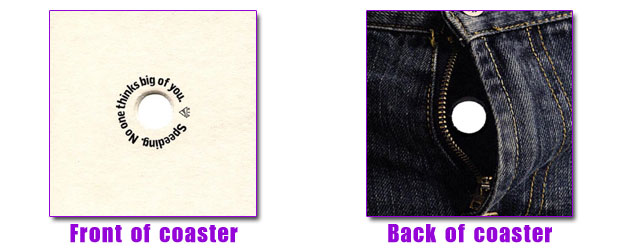
![]()
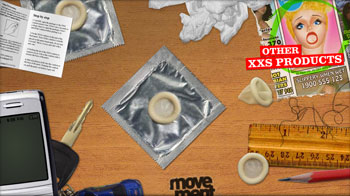
For the RTA, Clemenger Proximity developed a website called CashewBoy.com. What could the size and shape of a cashew have to do with this campaign? According to the submission to the Effie Awards, ‘The XX Small condom – strictly for guys who liked “tearing it up” at any given opportunity – was advertised virally and led to CashewBoy.com where you could find out how you measured up and send a speeding mate a friendly message.’ There is nothing friendly about the message.
One of the links shows a blow-up sex doll called ‘Mini-mouth Mandy’ whose mouth opening narrows to suit the size of the small penis. The online animation talks when a user presses any of the keyboard keys from 0 to 9. Here are the ten recordings. How can anyone say that this campaign is not about humiliation based on the size of the penis?

To listen to Mini-mouth Mandy speaking, click on the green play button below for all ten insults that degrade the penis. The last one says, ‘So, this explains the way you drive’. The RTA and its ad agency Clemenger BBDO recognise that men drive fast in order to compensate for other areas of their life, such as to seek approval, to be cool, to impress friends, to bolster their manhood, and to show off. They try to boost their self esteem. Mandy hits the nail on the head. Boys drive badly because they feel inadequate in some way. One of the aspects of their problems is their manhood, including shaving, puberty, and virility, as well as penis size. Youths are impressionable. They dare not deviate from the norms of peer-group fashion. They wear similar haircuts and similar colours and similar jewellery, and they follow each other in terms of piercing and tattoos. They are so impressionable, that they would worry about someone putting them down. Insulting their manhood by associating ‘loser’ with ‘small penis’ is compounding the original problem.
[audio:Mandy_Mini_Mouth_Cashewboy.mp3]Clicking on the ruler brings up text that says, ‘How do you measure up?’ Clicking on the ruler takes the vsitior to a page where a PDF file can be downloaded. The small print reads, ‘Print out page and push root of erect penis against broken line for relative comparisons.’ The chart below references Robert Latou Dickenson. I believe his name was Dickinson (1861-1950).
This chart fails to note that an average penis at 15 cm seems to ignore Australia’s multicultural population. Certain young men of a certain racial background will have vastly different sizes. Asians, in general, are much much smaller than this chart is suggesting. This chart is irresponsible because it omits any data to show its age and the age of the respondents to Dickinson’s experiments as noted in his ‘Atlas of Human Sex Anatomy’. The chart also fails to provide data relevant to males around the age of P-Platers, by ethnicity. Young men in the RTA’s target group might not be fully developed sexually. The RTA was specifically targeting P-Plate drivers. Such young men might not have completely matured, and might indeed follow the RTA’s suggestion, place their penis on the chart, and feel that they are not yet in the race, thereby raising their anxiety about needing to prove their manhood. The campaign as trying to simmer down one’s obsession with manhood. Yet this chart inflames it.
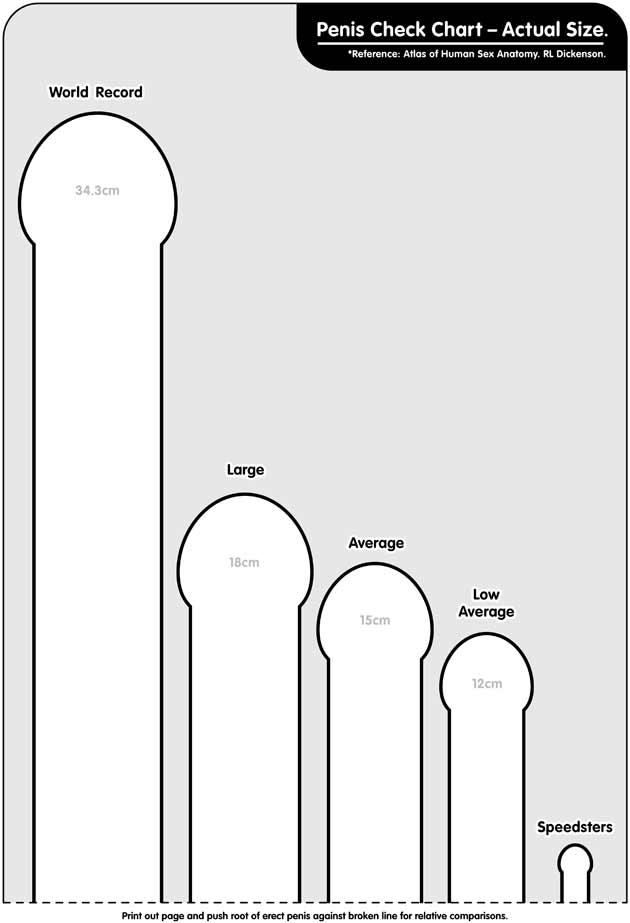
I remind you that the Advertising Standards Bureau, along with its Board, asked the RTA to respond to the complaint that the pinkie campaign is demeaning and insulting. The RTA said, ‘We reject the suggestion the advertisement is discriminatory and humiliates men.’ Here is the scan from the report:
![]()
When challenged that the pinkie gesture puts men down, the RTA said, ‘We reject the suggestion the advertisement is inflammatory. The gesture is never directed at the driver, there is no confrontational elements incorporated into the advertising at all.’ Here is the scan from the report:
![]()
How can the RTA keep a straight face and say that the gesture is never directed at the driver? How can the Board miss this diatribe?
Will the RTA argue here that the TV ad is not the same as the other elements of the campaign? Unfortunately, the RTA cannot separate one element from the other, partly because by its own admission, when dowsing criticism levelled at it, it wrote, ‘It is the first step in a multi-phased approach…’ Here is the scan from the report:
 When asked to respond about the ads being sexist, the RTA said, ‘We reject the suggestion the advertisement is sexist. It is evidenced based as discussed above.’ Here is the scan from the report:
When asked to respond about the ads being sexist, the RTA said, ‘We reject the suggestion the advertisement is sexist. It is evidenced based as discussed above.’ Here is the scan from the report:
![]() All I can say is, ‘poppycock’. The RTA is pulling the wool over the eyes of the Board by using impressive statements like ‘evidenced based’. It would not be difficult to gather any type of evidence from a range of citizens from NSW who could skew any report, any-which-way, to arrive at evidence to show that the community supports any extreme position you would care to name. Just because an advertiser can conduct focus groups and have people nod in agreement about certain campaign strategies does not exonerate the advertiser. The Advertising Standards Board ought to have dismissed this vacuous response from the RTA. Anyone can conduct a focus group that shows that people want all sorts of things, or agree with all manner of strategies. That hardly matters. I am sure that for every person who complained about the banned Nando’s double breast chicken ad, I could furnish one thousand people who would say that they see nothing wrong with it. Anyone who dares to defend themselves based on ‘evidence’ had better furnish all the study results, methodologies, questions, and any other influencing factor. So here we have a self-regulated Bureau accepting self-conducted research as evidence and as defence? That is tipping the balance into another realm.
All I can say is, ‘poppycock’. The RTA is pulling the wool over the eyes of the Board by using impressive statements like ‘evidenced based’. It would not be difficult to gather any type of evidence from a range of citizens from NSW who could skew any report, any-which-way, to arrive at evidence to show that the community supports any extreme position you would care to name. Just because an advertiser can conduct focus groups and have people nod in agreement about certain campaign strategies does not exonerate the advertiser. The Advertising Standards Board ought to have dismissed this vacuous response from the RTA. Anyone can conduct a focus group that shows that people want all sorts of things, or agree with all manner of strategies. That hardly matters. I am sure that for every person who complained about the banned Nando’s double breast chicken ad, I could furnish one thousand people who would say that they see nothing wrong with it. Anyone who dares to defend themselves based on ‘evidence’ had better furnish all the study results, methodologies, questions, and any other influencing factor. So here we have a self-regulated Bureau accepting self-conducted research as evidence and as defence? That is tipping the balance into another realm.
So let us re-visit the question: is this campaign about the penis? Despite three reviews, the Advertising Standard Board said that the pinkie sign would be understood by most people in the community to be reflective of the juvenile behaviour by the person, rather than specifically to the size of his penis or his manhood. Here is the scan from the report with yellow highlights added by me:
 Yet, in a previous report, the Board had said, ‘The Board considered that most people would understand this to mean, not that the person has a small penis per se, but rather that the person is less of a man…’ The statement above contradicts the statement below. Isn’t this sad and embarrassing and totally unacceptable! Above it denies that the Pinkie sign refers to ‘manhood’, yet below it admits that the sign points to someone ‘being less of a man’. How can ‘being less of man’ not be about ‘manhood’? Here is the scan from the report with yellow highlights added by me:
Yet, in a previous report, the Board had said, ‘The Board considered that most people would understand this to mean, not that the person has a small penis per se, but rather that the person is less of a man…’ The statement above contradicts the statement below. Isn’t this sad and embarrassing and totally unacceptable! Above it denies that the Pinkie sign refers to ‘manhood’, yet below it admits that the sign points to someone ‘being less of a man’. How can ‘being less of man’ not be about ‘manhood’? Here is the scan from the report with yellow highlights added by me:

In Clemenger/RTA’s submission to the Effie Awards, it notes that young males drive with their penises. It mentions balls and pussy as well. It seems to me that the whole campaign was all about the penis. It was all about manhood.
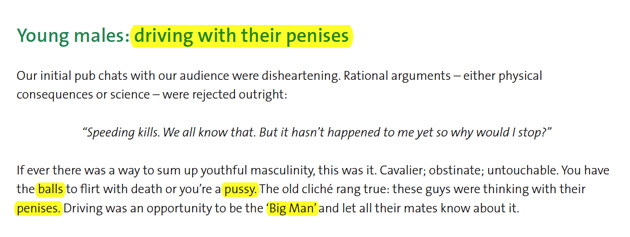
4) Is the campaign insulting and demeaning?
All along, the RTA has denied that the pinkie campaign is in any way demeaning. Yet here, in a submission for the Effie Awards, RTA and Clemenger give examples of why the ad has been effective. It quotes a female saying that the advertiser ‘…had done a great job of demoralising some of these guys…’ A male was quoted as saying, ‘…talking about a small penis and speeding is really effective for your male ego.’
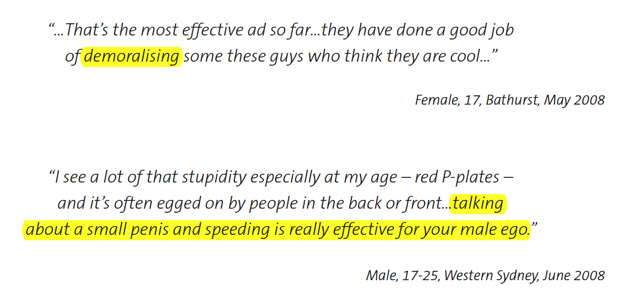
There is something flip-floppy about this campaign. No two sentences make sense. The submission to the Effie Awards includes media clippings. Why does the RTA and Clemenger show a newspaper headline, ‘Let the pinkie ads run, real men not offended’? So, are male drivers offended? Is anyone offended? Maybe it is saying that NOT-real men are offended, and that is precisely what’s wrong with this ad. Of course real men are not offended. Whereas young men are offended, especially if they have issues and problems associated with their physical size, their penis size, their ego, their lack of meaningful relationships, their lack of ‘enough’ sex, their lack of muscle and power and influence, and their lack of intimacy or acceptance or self-esteem. They are so humiliated and offended that they are changing their behaviour through the very intimidation that they were hoping to overturn. Now they have to suffer more of it! It is not the role of an advertiser to create such inadequacies in the very men who perform badly due to a range of inadequacies, while at the same time, telling society that any and all males with small dicks are not up to par and not complete men. They are ridiculed to such a degree that people make fun of their condition. Is this like making fun of the disabled? Right on par, dear reader.
My goodness, we cannot show a woman with breasts on TV, yet we can humiliate a man about his penis and his manhood. This campaign was effective because it was demeaning! We can be glad that it was effective, but horrified at the method taken. Do the ends justify the means? If so, maybe the Taliban is onto something. China’s dictatorship is onto something…
If this campaign were not so shocking and so alarming and so demeaning and so outrageous, it would not have been the third-most emailed story in the world. It would not have received such global media attention. Why was it attractive? Why did so many media outlets and TV and radio shows take up the story? Because it had balls. It had guts. It hit hard. This hard-hitting approach is proof-point that it was stunning in its news value.
No-one is denying the need to hit the message home to young drivers. But if the ends justify the means, then why do we have the Advertising Standards Bureau and why do we have codes of conduct?
I trust that I have shown you why this ad is a bad ad. Not everything in life can be measured in terms of profit, and not all ads can be measured in terms of effect. Sadly, the Effie Awards website says, ‘The Effie Awards honour the most significant achievement in advertising and marketing communications: effectiveness.’ I do not believe that the only thing that matters in ads is their effect. Responsible people must also consider the side-effect!
P.S. It’s all well and good to protest. It helps if the protester could offer some suggestions about tackling the problem. For this reason, I have posted my recommendation to the RTA about how we might combat some of the problems associated with speeding, bad driving, and fatalities. I have been talking about this issue for over ten years. I have conducted many radio interviews about the topic. I have posted my recommendations here.
This article was written by Jonar Nader, author of ‘How to Lose Friends and Infuriate People’. Jonar is a consultant whose website is www.LoseFriends.com


Comments are closed.